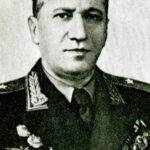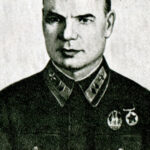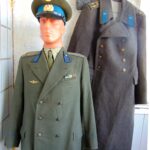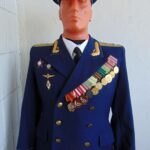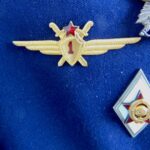The Museum of Aviation and Cosmonautics in Le Bourget has a large section dedicated to the Soviet aircrafts and the pilots during the Second World War and, of course, the Cold War. The collection is constantly replenished, especially in the pavilions “Normandie-Niemen” and “Cosmonautics in the USSR and Russia”. Friends of the Le Bourget Museum prepared this section of the Guide, which contains a description of the Soviet aircrafts, the pilot training, the uniforms and insignias, and contains a unique photo gallery. This Guide is based on our own archival materials and is especially relevant due to the fact that the world-famous Gagarin Air Force Academy in Monino ceased to exist in 2008 due to the “Army reform”, and since 2011 the remnants were transferred to the city of Voronezh to the base local military school. Below we place the official and unofficial archival materials for the each period of the Academy’s existence in accordance with the political ideology of the year the document was published. By reading these documents, you will be able to better understand not only the development of the aviation and astronautics in Russia, but also the political ideology for the each period of the reign of Stalin, Khrushchev, Brezhnev, and so on.
Air Force Academy named after Yu.A. Gagarin
Version 1984, Monino, Moscow region, USSR.
Introduction. From the first days of Soviet power, V. I. Lenin closely followed the development of aviation, took care of its technical equipment, and the training of proletarian aviation personnel. Faithful to the precepts of their leader, the Communist Party and the Soviet people created a mighty Air Force capable of reliably protecting the air spaces of the world’s first socialist state. By the end of the 1930s, fundamental qualitative changes had taken place in Soviet aviation. The speed and altitude of aircraft flight, the firepower and strike power of fighters and bombers have increased. The increased role of aviation in the war led to the further development of the aviation industry and the formation of new aviation units. Corps appeared as part of the Air Force, and from 1936, the first operational formations. The Air Force has become a branch of the Armed Forces capable of solving major operational-strategic tasks in modern warfare.
In the prewar years, the Communist Party and the Soviet government, guided by Lenin’s teaching on the defense of the socialist Fatherland and the strengthening of the military might of the country, made a number of decisions on the training of command aviation personnel. On March 29, 1940, the People’s Commissar of Defense issued an order to establish the Air Force Academy for the command and navigation staff of the Red Army Air Force. The formation of the academy took place in the difficult conditions of the Second World War unleashed by the imperialists.
- The first head of the Academy Z. Pomerantsev (photo 2)
- First Academy Commissar ( Political Commander) M. Izotov (photo 2)
The perfidious attack of fascist Germany on the Soviet Union radically changed the content of the educational process and the life of the academy: experienced teachers and senior students went to the front. But the hard work of the personnel did not weaken. The trainees were trained in such a way that their training fully met the needs of the front. Bit by bit, information was collected about the combat operations of aviation, the material received was comprehended theoretically, the scientists of the academy developed and sent manuals and manuals to the troops on tactics, operational art of the Air Force, control, piloting, bombing and aerial shooting.
During the Great Patriotic War, the academy trained a large detachment of aviation commanders who, in the fight against the enemy, demonstrated boundless devotion to the socialist Fatherland, unwavering loyalty to military duty. The graduates of the academy, having shown high combat skills, courage and bravery, made a worthy contribution to the victory of the Soviet people and its Armed Forces over fascist Germany. For outstanding success in the training of highly qualified personnel, by the Decree of the Presidium of the Supreme Soviet of the USSR of August 18, 1945, the Air Force Academy was awarded the Order of the Red Banner.
In the post-war years, new complex tasks arose before the academy. It was necessary to give a higher military education to the officers who participated in the battles, to comprehensively study, generalize and introduce into the educational process everything new that the experience of the past war had given. Participants in recent air battles formed the backbone of the leadership and teaching staff of the academy, headed the most responsible areas of activity. This made it possible to deeply generalize the experience of the Air Force combat operations in the Great Patriotic War, to create sound teaching aids and operational-tactical developments.
At present, the Air Force Academy is a large modern educational and scientific center of the Air Force, which has trained and educated several thousand highly qualified aviation commanders who are infinitely devoted to the Communist Party and the Soviet people. Among her students are three times Hero of the Soviet Union, Colonel-General of Aviation I. N. Kozhedub, 39 twice Heroes of the Soviet Union and 636 Heroes of the Soviet Union.
The Academy took an active part in the training of pilot-cosmonauts. By the Decree of the Council of Ministers of the USSR of April 15, 1968, the Red Banner Order of Kutuzov Air Force Academy was named after Yu. A. Gagarin. Many pilot-cosmonauts of the Soviet Union and the socialist countries that are members of the Interkosmos community studied here. These are twice Heroes of the Soviet Union V. A. Shatalov, G. T. Beregovoy, P. I. Klimuk, A. V. Filipchenko, A. A. Gubarev, V. V. Kovalenok, 10. V. Romanenko and others, and also Heroes of the Soviet Union, citizen of Czechoslovakia Vladimir Remek, citizen of the GDR Zygmund Yen and citizen of the Socialist Republic of Vietnam Pham Tuan.
The Academy makes a significant contribution to the building and development of the Soviet Air Force, to the development of the theory of operational art, Air Force tactics and all types of support for combat operations of troops.
From the first days of the existence of the academy, the teaching staff paid great attention to military scientific work. The volume of scientific research especially increased during the period of re-equipping the Air Force with jet aircraft, when combat units were in dire need of manuals and manuals for the use of fundamentally new aviation equipment and weapons in combat and operations. Special research groups and laboratories were created to carry out fundamental and applied research. Academic textbooks and works of scientists became the theoretical basis for the combat and operational training of aviation units and formations. In the future, the content and direction of scientific research at the academy was determined by the ever-increasing volume of tasks assigned to the Soviet Air Force. The more complex the tasks became, the more the scientists of the academy paid attention to their theoretical substantiation. In the 1970s alone, more than 500 major scientific studies were carried out at the academy. The close connection of the academy scientists with the life of the troops makes it possible to quickly take into account all the changes in the combat and operational training of aviation, to theoretically generalize what is new in military practice and build the educational process in such a way that classes are conducted in an environment as close as possible to the real conditions of modern combat and operations.
For the great achievements in the training of the aviation personnel and in the commemoration of the 50th anniversary of the Soviet Armed Forces, the Academy in February 1968 was awarded the Order of Kutuzov, 2nd degree. In April 1970, for high performance in combat and political training, she was awarded the Lenin Jubilee Certificate of Honor, and in December 1972, the Jubilee Badge of Honor of the Central Committee of the CPSU, the Presidium of the Supreme Soviet of the USSR, the Council of Ministers of the USSR and the All-Union Central Council of Trade Unions “50 years of the USSR.”
The merits of the Academy are well known not only in the Soviet Union, but also beyond its borders. Fulfilling its international duty, since 1946 the academy has been training aviation personnel for the socialist countries. The governments of the People’s Republic of Bulgaria, the Socialist Republic of Vietnam, the German Democratic Republic, the Polish People’s Republic, the Mongolian People’s Republic and the Czechoslovak Socialist Republic noted with high awards the academy’s fruitful work in training and educating command personnel for the national air force.
Thanks to the constant concern of the Communist Party and the Soviet government for the Armed Forces, the improvement of the training of command personnel, significant qualitative changes have occurred in the academy in recent years. Curricula and programs, educational and practical base fully meet the modern development of science and aviation technology. The Academy has a large team of highly qualified specialists, many of whom are doctors and candidates of sciences. The level of political and educational work is constantly being improved at the academy. The political department and party organizations cement the staff of the academy and direct its efforts towards solving the tasks assigned to higher education, the Central Committee of the CPSU and the Soviet government. The Air Force Academy owes its successes and achievements primarily to the large and close-knit detachment of communists who, heading the faculties, departments, research divisions, lead the entire personnel of the academy, mobilizing them for the successful implementation of the decisions of the 26th CPSU Congress.
Much attention in the educational process is paid to educating teachers and students of high ideological and political, combat and moral and psychological qualities, improving operational and tactical training, instilling command skills, the ability to quickly and competently make decisions based on modern scientific methods in any combat situation, using a computer.
The communists of the academy are well aware of their place and tasks in the struggle to achieve the milestones set for the Armed Forces of the USSR by decisions of party congresses, resolutions of plenums of the Central Committee of the CPSU and the Soviet government. They are deeply aware of the harsh reality of our time – the increased military danger – and the demand of the Communist Party not to lose sight of the issues of strengthening the country’s defense might for a single day. In modern conditions, when the volume of combat missions solved by aviation has sharply increased, it is the duty of the Communists of the academy to provide high-quality training of high-ideological air fighters devoted to the Party and the people, in fact, to fulfill the order of the XXVI Party Congress – “to reliably stand guard over the peaceful, creative work of the Soviet people.”
Table of contents. Chapter 1: The Beginning of the Journey
1. Formation of the academy.
to be continued soon..
Air Force Museum
Important work on the military patriotic education of students of the academy, personnel of the Armed Forces, the broad masses of working people is carried out by the Museum of the Air Force, founded at the academy. It contains over 120 aircraft, helicopters and gliders, over 120 aircraft engines, over 200 aircraft models. The museum has a wide range of aviation weapons, ammunition, communications equipment. It has a large number of military relics, authentic historical materials, documents and works of art.
The exposition of the museum shows the outstanding role of V. I. Lenin and the Communist Party in the formation and development of Soviet aviation, reveals the origins of patriotism and unparalleled heroism of Russian aviators during the First World War and the Civil War, while fulfilling their international duty in the fight against fascism in Spain and the Japanese invaders in China and Mongolia. Particular attention is paid to showing the mass heroism of Soviet pilots during the Great Patriotic War.
Thanks to the search work carried out by the museum staff – aviation veterans M. V. Shishkin, K. P. Danilin, A. Shcherbakov, N. I. Ampleev, V. P. Zaitsev, A. M. Mansurov and B. A. Berdnikov , MiG-3 fighter aircraft, Il-10 attack aircraft, Pe-2 and Tu-2 bombers, Po-2 and Li-2 aircraft were found and included in the exposition. The talented museum restorers-masters I. V. Aleksandrov, N. I. Tsyganov and P. A. Kozlovsky found and restored the aircraft of the period of the birth of aviation and the times of the First World and Civil Wars “Farman-4”, “Voisin”, “Sopvich” , as well as the first Soviet all-metal aircraft ANT-2.
Recently, the museum received the legendary armored attack aircraft Il-2, which had lain in the swamps of the Novgorod region since the Great Patriotic War and was restored in the S. V. Ilyushin Design Bureau. One of the mass-produced Yak-9 fighter aircraft was transferred to the museum by the Bulgarian comrades and repaired in the Design Bureau of A. S. Yakovlev. The museum received life-size models of the ANT-25 aircraft and the veteran of the Russian bomber aviation Ilya Muromets, which were used in the filming of the film Poem of Wings. In the taiga on the territory of the Chita region, the famous aircraft of the pre-war period, the high-speed bomber SB (ANT-35), designed by A. A. Arkhangelsky, was found, which was restored in the Design Bureau named after A. II. Tupolev. In various regions of the country, TB-3 and Pe-8 (TB-7) aircraft were found and delivered to the museum for restoration.
The exposition of the museum was replenished with the world’s first supersonic liner Tu-144. In the near future, the An-22 aircraft will appear in it, as well as some modern aircraft of the Design Bureau named after A.N. Tupolev, P.O. Sukhoi, helicopters M.L. Mil and N.I. Kamov.
- Monino Air Force Museum travel guide and virtual tour
Gagarin Air Force Academy uniforms, badges and insignia
Since the founding of the Military Academy in 1940, uniforms for teachers and students have been standard for the Air Force and have changed in accordance with orders and changes. In 1950, for those who graduated from the Air Force Academy, a special white silver diamond and an overhead nameplate (shield) with the name of the Academy were installed. In 1957, the shield with the name of the Academy was canceled, but, according to old military traditions, it continued to be worn in violation of the order. Every year, Academy graduates officially received this diamond with the name. After the Academy was named after Yuri Gagarin, this name also appeared on the shield field, which was used until the Academy was disbanded in 2011.
After the collapse of the USSR in 1991 during the Russian Federation, the leadership of the Ministry of Defense also tried to depersonalize the graduation signs of all military academies and introduced a new diamond without a shield with the name, replacing the red star with a square, and the coat of arms of the USSR with a double-headed eagle. In 2007, by Order of the Minister of Defense, changes to the appearance of the diamond were introduced, and the red square was abolished. Continuing old Soviet traditions, Academy graduates continued to wear the new Russian type of badge, but with a shield with the full name, including the name Yuri Gagarin. Traditional rhombuses with a violation of the order and the inscription of the name of the Academy were ordered by the course management or individually from commercial companies. As a result, graduates wore official diamonds with a Russian eagle without a shield, or traditional unofficial ones with a shield and the name of the academy. After the merger of the two academies into one, the new hybrid academy had a double name named after Yuri Gagarin and Professor Zhukovsky, which was indicated on an unofficial sign. After the transfer of two Academies from Monino to Voronezh and the formation of the Military Scientific Training Center, the name of Yuri Gagarin was preserved along with the name of Zhukovsky.
At military parades on the Red Square in honor of the Victory Day on May 9, participants were officially ordered to wear copies of the Soviet insignia of military academies. For example, the Zhukovsky Military Engineering Academy in 2008 was held in a new blue uniform designed by Valentin Yudashkin, but with copies of the Soviet diamond with shields with the name of Zhukovsky. This gave the moral and official right to wear Soviet-style diamonds. The guide’s authors’ collection contains authentic examples of this full uniform and insignia from this military parade of one of the participants.
- HQ colonel Teteryadchenko everyday uniform, 1960 (Cold War Museum USA)
- Teteryadchenko parade uniform at 1960 (M1955), M.B. private collection
- 1st class pilot and Soviet military academy M1957 badge, diamond or float
Gagarin Air Force Academy sleeve insignia
Until 2004, the uniform and sleeve insignia were standard for the Air Force, including a Russian flag shield on the left sleeve and a circle with the Air Force emblem on the right sleeve. In 2004, the Yuri Gagarin Air Force Academy introduced its own sleeve insignia in the form of a circle and emblem. The green open jacket with a tie and two round stripes on the sleeve was very reminiscent of the uniform of the US Army and NATO countries. According to the 2004 order, the second round badge belonged to the Air Force and was worn on the other hand. Military parades since the Cold War have had the peculiarity of mirroring the movement of all insignia so that the leaders of the Soviet and then the Russian state, located on the podium of the mausoleum with Lenin, saw the beauty and emblems. This old tradition poses great challenges for collectors and historians of military uniforms and insignia. Probably, according to this very tradition, the author’s collection contains a ceremonial uniform of the Gagarin Air Force Academy from 2004-2008 with two identical insignia on both sleeves. This confirms the improved quality of the chevron itself, embroidered with silver and gold threads instead of plastic stamping for everyday wear. Thus, the Yuri Gagarin Air Force Academy had its own insignia only from 2004 to 2008, before the introduction of new uniforms and merger with the Zhukovsky Academy.


